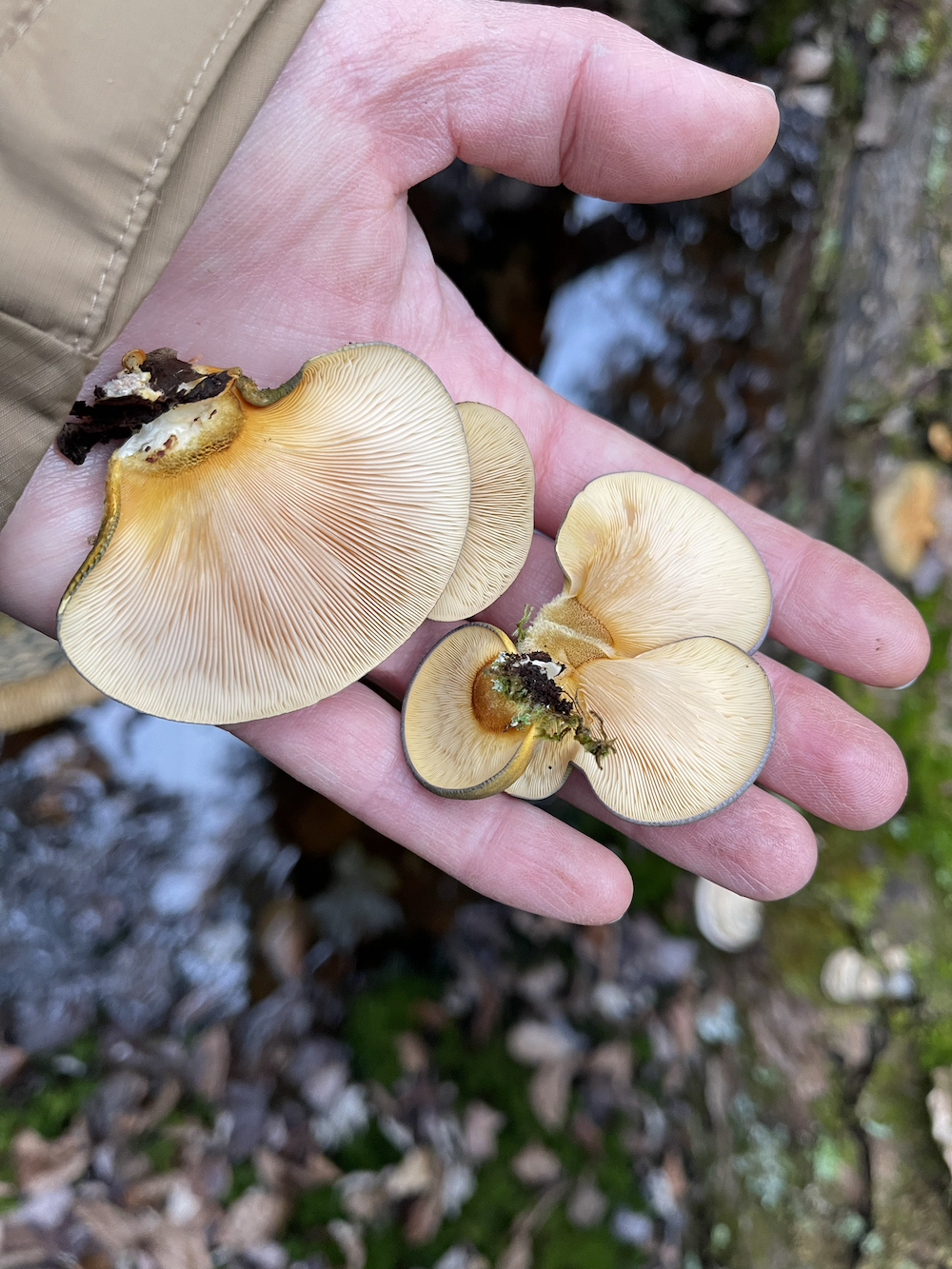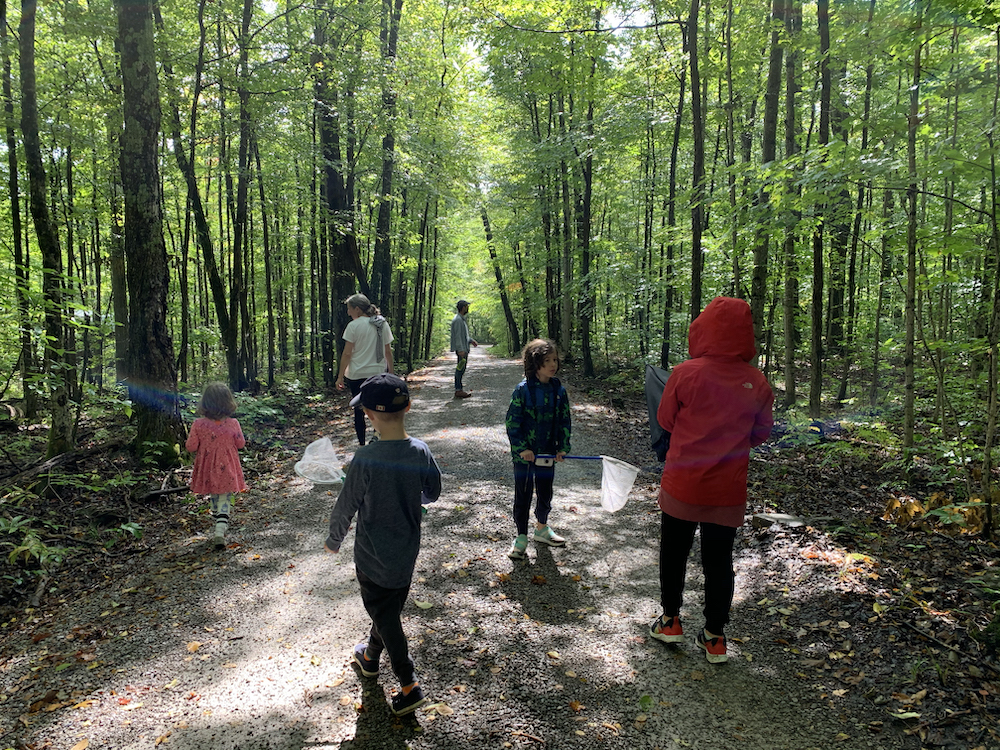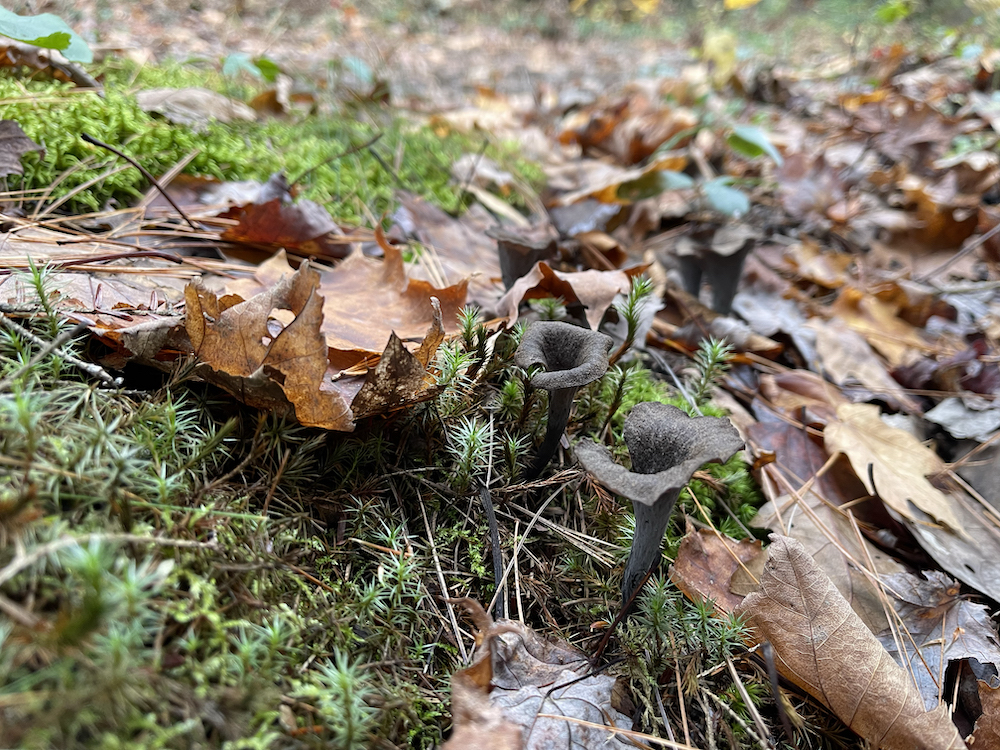The Fungal Classroom: What mushrooms can teach us about natural relationships
Text by Tara McCarthy, OALA
My mouth waters as I think of morels, chanterelles, hedgehogs, and boletes melted into pounds of butter and garlic, turning my pizza, pasta dish, and breakfast omelette into gustatory indulgence. These natural mushroom treasures we have foraged with our hands, cleaned and prepared in our kitchen—a process that is always punctuated by the stories of the day’s adventures that lead to our finds. I smile as I picture my children moving through the forest, squeals of excitement pulsing through the landscape, treasures found, and I revel in the memories of my own childhood hikes, where every little forest jewel was a curiosity. I take a deep breath as if, for a moment, I am deep in the forest and the complex earthy smells fill me with comfort. The cycles of life and decomposition beneath my feet generate the umami of the forest olfactory palette.


Mushrooms are the fruiting bodies of a highly complex organism network called mycelium that feeds and grows by digesting surrounding organic matter. Fungi, the kingdom that mushrooms belong to, are neither plant, nor animal, and are incredibly fascinating members of our biosphere. They show up in every corner of our planet and clearly speak of the ecological fabric. They are calendars of time, seasonality, and cycles of life, nutrients, and decay. The myriad shapes, colours, flavours, and textures of the fruiting body have captivated the imaginations, spirits, and souls of humans for thousands of years. Evidence of this shows up in archeological and cultural remnants, lore, art, symbology, artefact, and remains. Today, the number of websites, social media groups, YouTube channels, and media focused on the many aspects of mushrooms are proof that human fascination with the world of mushrooms has not waned. There are Facebook and Instagram groups dedicated to foraging, field identification, emergency identification, cultivating, conserving, cooking and eating, psychedelics and pharmacology, and medicinal benefits—and these are just some of the groups I personally follow. Prominent mycologists are in the spotlight, captivating TED Talk audiences and the like with the wonder of the kingdom of fungi. It would be a dishonour to not mention Paul Stamets here, and, having seen him speak long ago at an event at the Toronto Botanical Gardens, I can attest that his passion, creativity, and brilliance blew open my mind as to what a mushroom is. I strongly recommend investigating the research and work done by mycologists worldwide. They are enigmatic storytellers, activists, innovators, and impassioned scientists with an incredibly different perspective of living systems.

My father is an avid amateur naturalist, and growing up, family vacations were spent outside, with the mosquitoes, often knee deep in marshes and swamps, looking for obscure little brown birds. Mushrooms were always a treasure when found along the way. To be quite honest, when I was a kid, I hated eating them, but absolutely loved finding them, so I really didn’t care if they were edible or not—the shapes, colours, miniature worlds and fairy tales was what peaked my interest. I learned that they (mushrooms and fungi in general), along with the birds, plants, and rocks, tell a complex story of the surrounding ecology, geomorphology, seasonality, health of a system, age and stage of a system, co-dependency and relationships to other species, balances and imbalances, and this knowledge gave me an awareness to read a forest, meadow, stream bank, and urban wasteland differently, and was one of the main drivers that lead me to become a landscape architect.

As landscape architects, we have a tuned awareness to the natural environment. My process as a designer looks to find the language of the natural landscape, to humbly read what I can, and learn from the lessons spoken by the many voices of our planet. Mushrooms are one of my favourite teachers.

Environmental literacy is a mechanism of connectivity that every human should have the opportunity to practice. It is like understanding a little more about a culture by learning the language. It’s a mechanism for seeing the world through new eyes, a different perspective, a honing of observational skills. Developing a deeper understanding of a particular ecological component is a beautiful window into understanding our complex world a little more comprehensively.


I believe that a landscape architect’s role is pointed towards the greater good for the planet and that we are well positioned to lead, inspire, and guide society towards a heightened awareness and appreciation for nature and the value of protecting this incredible planet of which we are a part. The more I try to understand the world around me, the better I hope to be at including all species and elements concerned when making planning and design decisions. It takes only a quick internet search to see how many people are dedicating their lives and careers to understanding, testing and leveraging the incredible talents of mushrooms within their own specific ecologies, and as corrective and innovative solutions within the human sphere. I immediately think to the first time I specified a soil with mycorrhizae and felt closer to building the foundations for a healthy ecology. I tend to a colony of bees in my beehive, and I’ve read about the developments of mushroom mycelial treatments, by Paul Stamets, to combat “Colony Collapse Disorder”—a serious threat to food production worldwide. And my mind was absolutely blown when I read “The Hidden Life of Trees” by Peter Wohlleben and learned that trees’ fungal partners, interconnected mycelial networks, enable them to “communicate” and exchange nutrients with each other. A healthy forest is a whole, connected, communicating system. These are just a few of the ways mushroom research has changed the way I approach work and life.

Making a difference can be as simple as taking a hike and making note of the things we see. Citizen science has provided an incredible wellspring of data about our environment and its long term patterns of health and, sadly, decline. Avid bird watchers have contributed data, in the form of sightings, that has informed scientists of migration patterns, population distribution, dynamics, and health. I still go out with my father for one of the longest-standing citizen science events: the Christmas Bird Count. It happens all over North America, every year, and the census informs multiple bird conservation efforts. Mushrooms are as much a messenger of the state of environmental health, and there are many initiatives for reporting and contributing to mycology data collections like mushroomobserver.org and inaturalist.org. Participating in citizen science initiatives offers us, as landscape architects, the opportunity to learn in the field, and interface with knowledgeable and practicing scientists for a greater science- based understanding of ecology, while contributing to critical, sustainable, future-oriented initiatives.

I now take my kids out on the same kinds of trips my parents took me on, and I see them organically starting to make the connections with their natural world and spirit. I see them noticing more details, and developing a relationship to everything, attending to all creatures and living things with empathy and care.


We can’t end this exploration without bringing up the subject of foraging. I want to end this piece with some of my favourite resources, books, and a few tips for getting started, as well as with the compulsory warning that there are some mushrooms out there that can cause serious and life-threatening illness and death. Consuming a single destroying angel may very well be a last meal. Identification should be practiced first: books, books, books, Facebook groups, and real life forays with experts are the key to safely foraging and consuming mushrooms. But, as long as you take precautions, there is nothing like a treasure hunt in the fresh air, forest bathing, escaping today’s challenges, and the thrill of discovering hidden gems for the first time. A completely camouflaged black trumpet is the ultimate reward for finally seeing the almost indiscernible texture change between the leaf litter and the dark, curled trumpet. So:
1. Get outside, anywhere, and walk a little slower, spend the time to look carefully at textures, colours, and shapes of the landscape, and be newly curious about familiar places.

2. Read about mushrooms and learn their names—common, but more importantly latin. Learn their preferred ecologies, seasonality, hosts, favourite conditions, how to identify look-a-likes, and spore printing. My favourite guides are the Peterson Field Guide to Mushrooms, The Audubon Society Field Guide to North American Mushrooms, and Wild Edible Mushrooms of Ontario.

3. Join Facebook groups, they are the best resource. They are usually run by experts and filled with a whole community of people’s findings, questions, photos, and experiences. My favourite is “Ontario Mushroom Hunters and Foragers.”

4. Join clubs and/or go on forays. There is nothing like a day in the field with an expert. My favourite team of foraging leaders are “Fervent Finds.” I go on at least one of their trips each year and come home elated, muddy, tired, hungry, and with baskets filled with dinner’s delights.
5. Read about the other aspects of mushrooms and become fascinated by the whole kingdom of fungi. Some of my favourite books are Entangled Life: How Fungi Make Our Worlds, Change our Minds and Shape our Futures, Fantastic Fungi: How Mushrooms can heal, Shift Consciousness and Save the Planet, The Hidden Life of Trees, and Healing Mushrooms: A Practical Guide to using Mushrooms for Whole Body Health. Fantastic Fungi is also a phenomenal documentary I would highly recommend watching.

BIO/ Tara McCarthy, OALA, CSLA, has been Senior Landscape Architect at MT Planners for 18 years, working on a wide variety of projects across the globe focused on a natural systems approach to city design, with the goal of facilitating a deep connection between humans and the natural environment. Also, a lover of mud, trees, fresh air, growing veggies, and watching her children develop a respect and fascination for the wonders of our great planet.
